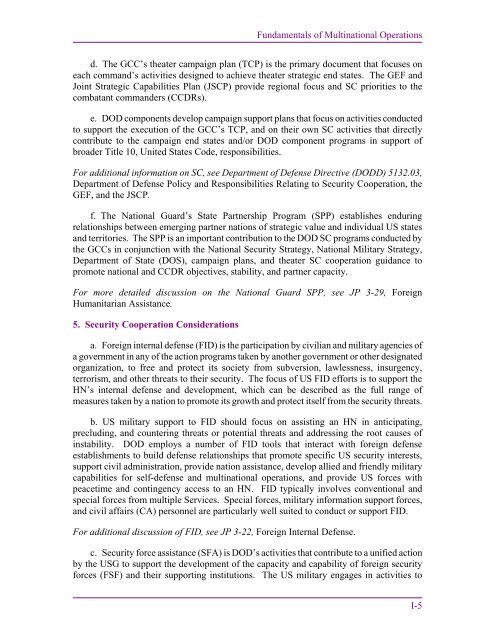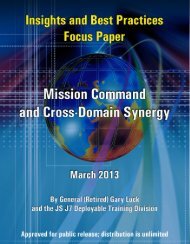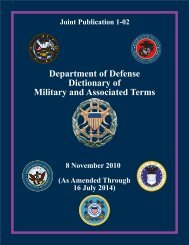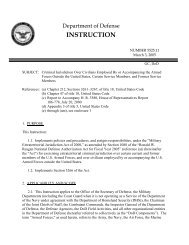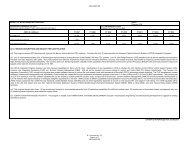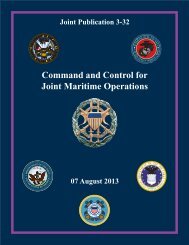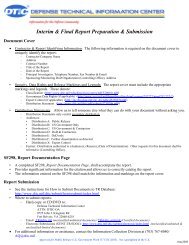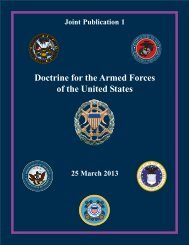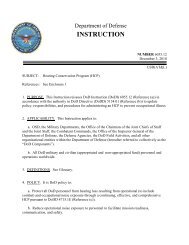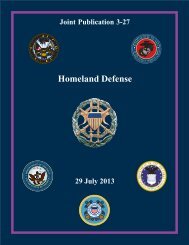JP 3-16, Multinational Operations - Defense Technical Information ...
JP 3-16, Multinational Operations - Defense Technical Information ...
JP 3-16, Multinational Operations - Defense Technical Information ...
Create successful ePaper yourself
Turn your PDF publications into a flip-book with our unique Google optimized e-Paper software.
Fundamentals of <strong>Multinational</strong> <strong>Operations</strong><br />
d. The GCC’s theater campaign plan (TCP) is the primary document that focuses on<br />
each command’s activities designed to achieve theater strategic end states. The GEF and<br />
Joint Strategic Capabilities Plan (JSCP) provide regional focus and SC priorities to the<br />
combatant commanders (CCDRs).<br />
e. DOD components develop campaign support plans that focus on activities conducted<br />
to support the execution of the GCC’s TCP, and on their own SC activities that directly<br />
contribute to the campaign end states and/or DOD component programs in support of<br />
broader Title 10, United States Code, responsibilities.<br />
For additional information on SC, see Department of <strong>Defense</strong> Directive (DODD) 5132.03,<br />
Department of <strong>Defense</strong> Policy and Responsibilities Relating to Security Cooperation, the<br />
GEF, and the JSCP.<br />
f. The National Guard’s State Partnership Program (SPP) establishes enduring<br />
relationships between emerging partner nations of strategic value and individual US states<br />
and territories. The SPP is an important contribution to the DOD SC programs conducted by<br />
the GCCs in conjunction with the National Security Strategy, National Military Strategy,<br />
Department of State (DOS), campaign plans, and theater SC cooperation guidance to<br />
promote national and CCDR objectives, stability, and partner capacity.<br />
For more detailed discussion on the National Guard SPP, see <strong>JP</strong> 3-29, Foreign<br />
Humanitarian Assistance.<br />
5. Security Cooperation Considerations<br />
a. Foreign internal defense (FID) is the participation by civilian and military agencies of<br />
a government in any of the action programs taken by another government or other designated<br />
organization, to free and protect its society from subversion, lawlessness, insurgency,<br />
terrorism, and other threats to their security. The focus of US FID efforts is to support the<br />
HN’s internal defense and development, which can be described as the full range of<br />
measures taken by a nation to promote its growth and protect itself from the security threats.<br />
b. US military support to FID should focus on assisting an HN in anticipating,<br />
precluding, and countering threats or potential threats and addressing the root causes of<br />
instability. DOD employs a number of FID tools that interact with foreign defense<br />
establishments to build defense relationships that promote specific US security interests,<br />
support civil administration, provide nation assistance, develop allied and friendly military<br />
capabilities for self-defense and multinational operations, and provide US forces with<br />
peacetime and contingency access to an HN. FID typically involves conventional and<br />
special forces from multiple Services. Special forces, military information support forces,<br />
and civil affairs (CA) personnel are particularly well suited to conduct or support FID.<br />
For additional discussion of FID, see <strong>JP</strong> 3-22, Foreign Internal <strong>Defense</strong>.<br />
c. Security force assistance (SFA) is DOD’s activities that contribute to a unified action<br />
by the USG to support the development of the capacity and capability of foreign security<br />
forces (FSF) and their supporting institutions. The US military engages in activities to<br />
I-5


